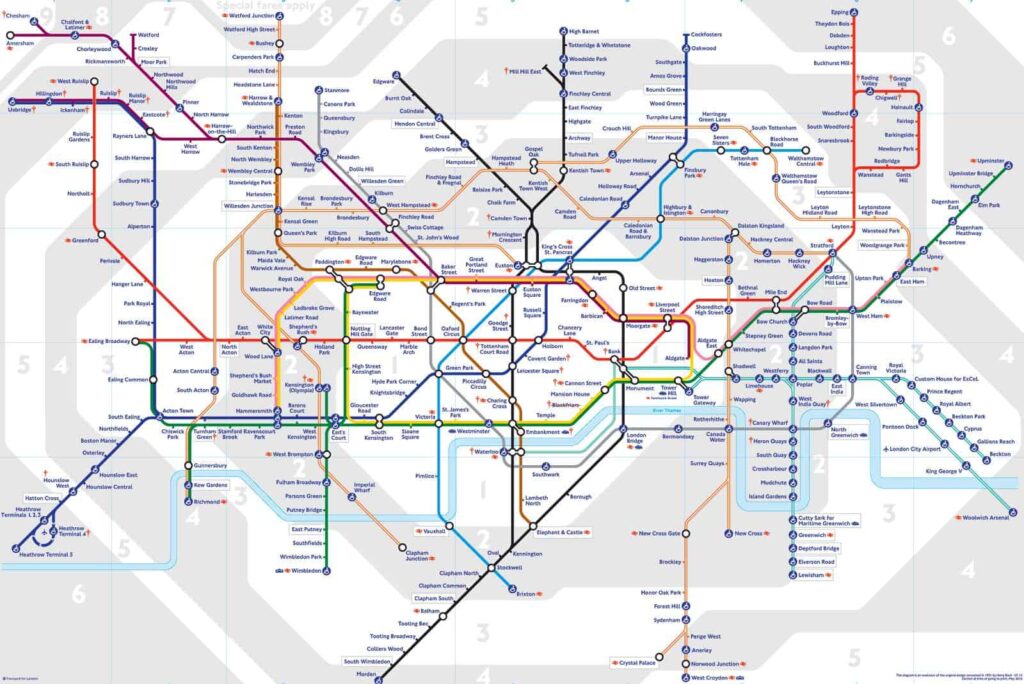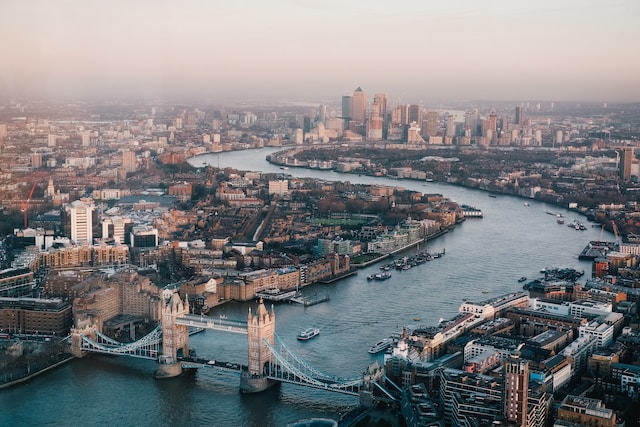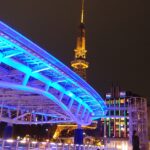In London, using the public transportation system is a terrific way to get around. Buses, tube trains, overground trains, trams, river buses, and bike rental services are all widely available in London. Transport for London, which oversees all of these services, provides regular commuters with a number of cheap passes and tickets. For transportation in the late evening and early morning, London offers a variety of night bus and tube services. All services are wheelchair accessible, and elderly and disabled customers are eligible for a number of discounts.
Metro system in London – Basic information
The enormous network of underground lines that makes up the London metro system connects all parts of the British metropolis. There are 272 stations and 11 lines in the system, and services run around every 2 to 5 minutes during peak hours. With its first opening in 1863, it is the world’s oldest underground train system. It is also a well-liked tourist destination with many fascinating stations and attractions, including the recognizable tube map. The ticket price is determined by the number of zones you cross under the zone-based fare structure. The London metro system is a dependable and effective means of transportation.
The lines of the London subway system
Bakerloo line
The London & North Western Railway (LNWR) main line, which debuted in 1837, runs alongside the Watford DC Line, which is also used by London Overground, between Queen’s Park and Harrow & Wealdstone.
Central line
In 1856, the Eastern Counties Railway built the railroad along the same route that is still in use today. This railroad segment extends from just south of Leyton to just south of Loughton. The Great Eastern Railway (GER) route between Loughton and Ongar, which was constructed in 1865 and passes through Epping, is also utilized by the Underground. The rail service between Epping and Ongar was discontinued in 1994, but the historic Epping Ongar Railway still uses the majority of the route.
Circle Line
From slightly north of White City to Ealing Broadway, the Great Western Railway (GWR) built the line in 1917. In 1920, the Tube commenced passenger service on this route. The GWR built North Acton to West Ruislip for the Tube in 1947 and 1948 using pre-existing rails from Old Oak Common junction to High Wycombe and 1904.
District line
District line south of Kensington (Olympia). The District had a 1958 bay platform at Olympia and a track on the 1862–3 WLR/WLER northward. The southbound WLR/WLER was converted into the northbound main line, and a new southbound main line track was built through the former goods yard.
The City and Hammersmith
Paddington to Westbourne Park Tube Station is parallel to the main line. The subway east of Westbourne Park and two tracks north of the main line commenced service in 1878. Hammersmith & City has its own track parallel to the main line.
Jubilee line
In 1847, this Canning Town-Stratford line began passenger service. The original alignment was quadrupled “in stages between 1860 and 1892” for freight services before the western tracks were lifted as traffic fell throughout the 20th century and re-laid for Jubilee line services that commenced in 1999. Before the Jubilee line alignment was re-laid. The Jubilee uses the western alignment while the Docklands Light Railway, now called the “ex-North London line,” uses the eastern route.
The Metropolitan line
From London’s Aldgate to Buckinghamshire’s Amersham and Chesham. It has branches in Watford, Hertfordshire, and Uxbridge, Hillingdon. It’s called the Met. On the tube map, the line is magenta and has a length of 66.7 kilometers and 34 stations (13 of which are step-free to the platform). The Central line is the other Tube line that travels outside Greater London.
Piccadilly line
LSWR built the Piccadilly line’s westbound track between Ravenscourt Park and Turnham Green in 1869 for eastbound main-line and District trains. Between Ravenscourt Park and Turnham Green is this track.
Victoria Line
The London Underground’s Victoria line runs through the West End from Brixton in the south to Walthamstow Central in the north-east. The Waterloo & City line is the other subterranean route on the network. The Tube map shows it as a light blue line, one of two totally subterranean lines. This line stops at 16 stations, 15 of which (excluding Pimlico) link to other Transport for London or National Rail services.
The Waterloo & City line (The Drain)
“The Drain,” the London Underground’s Waterloo & City line, runs nonstop between Waterloo and Bank. Most of its passengers commute from southwest London, Surrey, and Hampshire to the City of London financial district through Waterloo mainline station. Except in rare circumstances, the line has not run on Sundays or public holidays. Only two lines operate totally underground. The shortest line on the Underground, it takes four minutes to travel 2.37 kilometers. Tube maps show the line in turquoise.
Map of London Metro 2023 – Free Download in PDF

Click on the image and download the map of London´s underground system for 2023
Anybody who intends to travel to London in the following year absolutely needs to have the Map of London Metro 2023 in their possession. You may view all of the stops along each Metro line by downloading it in PDF format for free, which is an excellent method to organize your journey in accordance with your destination. Using the map, you will be able to decide the most direct and time-saving path to take in order to arrive at your destination as quickly as possible. In addition, the map details any modifications to the Metro lines that have been implemented since the publication of the previous map in this series. If you bring the Map of London Metro 2023 with you on your next trip to the city, you can ensure that everything goes as well as it possibly can.
Public transport tickets in London – Best types for travelers & actual prices
The Oyster Card is the first option, and it is an electronic smartcard that can be used on all of the public transportation systems in London, including buses, trains, trams, and the London Underground. Because it allows for cheaper prices and can have more credit added to it, it is an excellent option for anyone who wants to make frequent use of public transit. There are also travel passes valid for one day or seven days for those who only take the bus occasionally. These cards offer a specific length of time during which the holder is entitled to unlimited travel on all forms of public transportation in London, in addition to savings that apply to journeys done inside the central London area.
Tickets can also be purchased for tour buses and for cruises on the Thames River, both of which allow passengers to experience the city at their own leisurely pace. You have the option of purchasing a day ticket that allows you to jump on and off at any of the ports along the Thames River, or you can purchase a 24-hour ticket that grants you access to all of the ports along the river. The cost of sightseeing buses may be slightly higher, but they eliminate the need to switch between various modes of transportation, allowing passengers to visit all of London’s most famous attractions in a single outing.
Tickets for public transportation can range in price based on the type of ticket and the length of time it is valid for, but in general, a single journey on the London Tube will set you back $2.90, an Oyster Card can be purchased for $5, and a 7-day travel card will set you back $33.30. The price of a ticket good for 24 hours on a sightseeing bus is currently £14, which is a little increase.
A travel card valid for seven days is likely to be the most beneficial purchase for travellers coming to London for a stay of only three days. This will make it easier for you to go around the city, and you’ll also be able to take advantage of the deals that are offered in the central London area. Naturally, if you want to ride the tour buses quite a bit, the best way to maximize your money’s worth will be to purchase a combination ticket that allows you to ride on a variety of different buses.
Summary of fares for public transport in London
- Oyster Card: electronic smartcard for all public transportation; discounts on fares; additional credit may be loaded into the card.
- Travel passes one-day or seven-day passes that offer unrestricted travel and savings for journeys in central London.
- Day tickets or 24-hour tickets are available for purchase for tour buses and Thames River cruises.
- Costs change depending on the type of ticket and how long it is good for.
- The seven-day travel card is recommended for trips of three days or fewer.
Timetables & Schedules of the London Metro system
Every day, the London Metro system is responsible for transporting millions of customers, making it one of the most extensive and advanced public transportation networks in the world. On weekdays, service on the Metro system is available from around 5 am until midnight, while on weekends, service is available until 1 am. Many lines, including the Victoria and Northern Lines, operate nonstop around the clock. Also, the frequency of trains fluctuates not just throughout the day but also throughout the night, with rush hour trains arriving more frequently than nighttime trains and vice versa. In addition, the Metropolitan Transportation Authority (MTA) operates a Night Tube service on the weekends (Fridays and Saturdays), which gives commuters other options for traveling late into the night. In a nutshell, the London Metro system offers an extensive network of services to cater to the requirements of the millions of people that depend on it on a daily basis.
What Are Other Options For Public Transportation In London?
The metro isn’t the only kind of public transit available in London; in fact, it’s just one of several wonderful ways to move around the city. When traveling around London, commuters have a wide variety of choices at their disposal as a result of the availability of a number of additional possibilities.
The first possibility is using a public bus. These buses are one of the many ways that Transport for London (TfL), which is responsible for their operation, makes it easy and inexpensive to get around the city. Because the routes are so vast and reach so many different parts of London, they are an excellent option for people who want to go rapidly and without much difficulty throughout the city.
The London Overground is yet another transport choice. This is a system of trains that operate in and around the city as well as the surrounding suburbs. Because of its speed and effectiveness, the Overground is an excellent choice for commuters who are in a hurry to reach where they need to go.
If you’re searching for a way to get around London that’s a little more picturesque, you might want to think about renting a boat and going for a ride on the River Thames. You may take a relaxing boat ride up and down the river, taking in the sights and sounds of the city as you go. This is a great way to spend an afternoon.
In addition, a variety of additional modes of public transit can be found in London. The Docklands Light Railway (DLR) is a light train system that provides access to some of the most popular locations of the city. It travels through parts of East London and can be found in the region known as the Docklands. The Emirates Air Line is a cable car system that travels over the Thames, whereas the London Tramlink is a tram system that operates in South London. Both systems are located in London.
Lastly, residents of London have the option of making use of the city’s many bike routes. Cyclists can navigate the city with ease because to the nearly 400 kilometers of bike paths that are available here. You won’t have any trouble finding a place to rent a bike in London; thus, you’ll have no problem going at your own pace while you discover the city on two wheels.
How To Get From London International Airport (yxu) To The City Center With Public Transport?
Travelers who have never been to London before may find it difficult to navigate their way from London International Airport to the heart of the city. To travel to the heart of the city, however, the most dependable and cost-effective mode of transportation is the public bus. The following is an in-depth walkthrough of the most straightforward route to take while traveling from London City Airport to the heart of the city.
First, get the Tube into your mouth. To go from London International Airport to the heart of the city, taking the Tube is both the quickest and most cost-effective mode of transportation. After landing at the airport, you may hop on the Piccadilly Line, which will deposit you smack dab in the middle of London’s bustling financial district. The trip lasts for around an hour and a half and costs about six pounds for one direction.
Go to Step 2 and Board the Train. There is also the option of taking the train from London International Airport into the heart of the city if you are willing to wait a little longer. This trip takes approximately one hour and ninety minutes and costs approximately fourteen pounds for one way. There is a train that leaves the airport every fifteen minutes.
The third step is to ride the bus. The bus is yet another reasonably priced mode of transportation that can be utilized to get from London International Airport to the heart of the city. The trip into the heart of the city on the N9 night bus takes around one hour and ninety minutes and operates nonstop. The cost of a single trip is £2.50.
Step 4: Take a Cab. A cab is an excellent choice if you’re searching for a mode of transportation that will get you from London International Airport to the heart of the city in a quick and stress-free manner. Taking a cab from the airport into the heart of the city will cost approximately £45, and the ride will take approximately 45 minutes to an hour on average.
Using the public transit system, traveling from London International Airport to the heart of the city is quick, simple, and stress-free. The bus and the train are both feasible possibilities; however, the Tube is the one that is both the quickest and the most cost-effective. Taxis are the best kind of transportation to take if you want your trip to be less stressful and more relaxing. You won’t have any trouble reaching the heart of the city no matter which of the many options you go with.
What kind of sightseeing do you have to see if you visit London for the first time?
London is consistently ranked as one of the most visited cities on the planet. This lively city has a wealth of historical sites, cultural institutions, and landmarks recognized all over the world, ensuring that there is something for every visitor to appreciate here. The following is a list of some of the best places to visit in London, regardless of whether you are a visitor or a local:
The Tower of London. This world-famous castle can be found on the banks of the River Thames and is an absolute must-see for everyone visiting London. It is home to the Royal Jewels and has a long and illustrious history. The castle can be explored by guests, and they can also view the jewels and take part in guided tours to learn about the castle’s history.
This magnificent Gothic church is the customary location for the coronation of the British monarchs, and it is known as Westminster Abbey. Visitors get the opportunity to take part in guided tours, obtain information about the history of the church, and investigate the numerous tombs of notable persons from times gone by.
The London Eye is a famous Ferris Wheel that is considered to be one of the most popular tourist destinations in London. From its 135-meter-high vantage point, visitors can get breathtaking views of the city. Guests have the option to purchase tickets for a ride on the wheel, in addition to exploring the other attractions in the area.
The British Museum is a museum that can be found in the center of London and is home to artwork and artifacts that have been collected from all over the world. Visitors have the opportunity to peruse the numerous displays, participate in narrated tours, and obtain information regarding the establishment’s past.
This magnificent house is known as Buckingham Palace, and it serves as the official residence of the British monarchs. In addition to viewing the changing of the guard event, guests can enjoy a tour of the palace, during which they can investigate its various state rooms and gardens.
These are just some of the most popular places of interest that tourists flock to in London. There is something for everyone to do in London, whether you want to learn about the history of the city, take in the scenery, or visit some of the sites that are known all over the world.
Summary of our tour guide for London
London is a bustling and lively city that has a deep historical and cultural background. It has a vast network of buses, trains, and the world-famous London Underground, which makes it widely regarded as having one of the best public transportation systems in the entire world. The Thames Clipper is the only river bus service that operates on a daily basis in any city in the world, and London is that city. Trams, the Docklands Light Railway, and the London Overground are just few of the several modes of public transportation that are available in the city. Because of the effectiveness and dependability of London’s public transportation system, it is possible to go around the city without using a private vehicle.
Top 5 FAQs and answers about London public transport?
Can you tell me about the many modes of public transportation in London?
- The Tube (also known as the London Underground), buses, trams, the Docklands Light Railway (also known as the DLR), and Overground Rail are the most common forms of public transportation in London. There are almost 5 million trips taken on the Tube every single day, making it the most popular form of public transportation in London. Other common modes of transportation inside the city include buses, trams, and the Docklands Light Railway (DLR). In conclusion, the Overground Rail is the most efficient mode of transportation for longer travels, such as traversing the city from one end to the other.
Which method of payment for London’s public transportation is considered to be the most convenient?
- Oyster cards are the most convenient way to pay for rides on London’s public transportation system. Oyster cards are pre-paid travel cards that can be used on any form of London public transportation. These cards are issued by the Oyster network. You can buy an Oyster card at any Tube station, and you can add money to an existing Oyster card at any time. In addition, you have the option of paying for travel with a contactless payment card, an Apple Pay or Android Pay device, or cash.
What are the fees associated with using public transportation in London?
- The price that you will pay to ride the public transportation system in London will change depending on the mode of transportation that you will be utilizing as well as the distance that you will be traveling. In general, a single journey on the Tube will cost you between £2.90 and £3.00, whereas a ride on the bus or tram would cost between £1.50 and £2.00. There is also the option to purchase travel cards on a daily, weekly, or monthly basis, all of which provide discounted fares.
Is it risky to ride public transportation in London?
- The London public transportation system is extremely secure thanks to the various safety measures that have been put into place to protect passengers. A visible police presence is maintained on the Underground, and there are closed-circuit television cameras installed in every station as well as on all buses and trains. In the event that something goes wrong, passengers on buses, trains, and trams can use the built-in emergency call system.
Are there any deals or discounts that can be used on London’s public transportation?
- Certainly, there are a number of deals and discounts that can be found for London’s public transportation. Students, pensioners, and persons living with impairments are all eligible for discounts, to name just a few examples. There are further reductions available for longer journeys using travelcards, and the Oyster card comes with its own set of unique perks to take advantage of.
Useful links








1 thought on “London Underground”